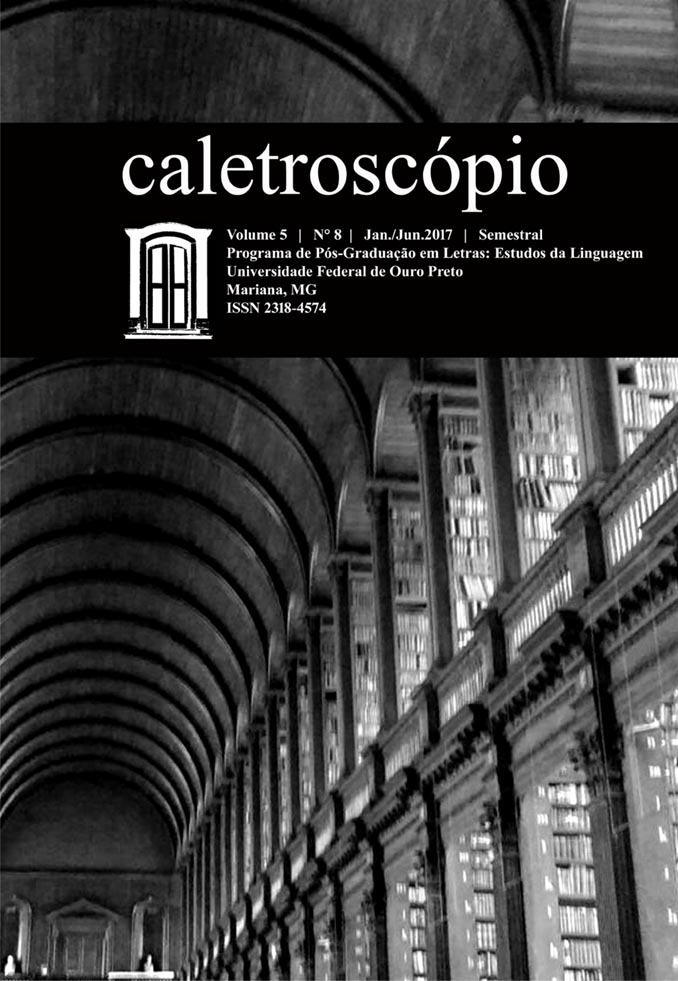Expressões de genericidade: um olhar para as teorias sobre definidos e nominais nus no Português Brasileiro
Abstract
O presente artigo aborda a genericidade nas línguas naturais, com maior enfoque no Português Brasileiro (PB). Seu objetivo principal é realizar um levantamento e discussão das principais teorias propostas para o caso da genericidade no sintagma nominal no PB, como foco no definido genérico e no singular nu (SNu). Dessa forma, baseando-se principalmente em Lyons (1999), abordamos de forma abrangente a discussão teórica sobre genericidade. Em seguida, discutimos as duas posições antagônicas para o caso da genericidade no PB: a de que o SNu no PB é um indefinido e, portanto, um NP (Müller (2002)); e a de que o SNu denota a espécie, ocupando a posição de DP (Schmitt e Munn (2002), Dobrovie-Sorin e Pires de Oliveira (2008)). Porfim, após discutirmos a proposta de Lyons (1999) e sua relação com as teorias propostas para o PB, realizamos uma breve análise sobre a distinção entre o definido e o SNu em relação à genericidade. Concluímos e concordamos com Müller (2002) de que há uma diferença entre o definido genérico e o SNu, mas por razões diferentes. Não porque apenas o primeiro denota um característica inerente e o segundo não é verdadeiramente um genérico (como afirma a autora), mas porque o SNu é um “property-generic”, denotando a intensão do nome.
Downloads
Download data is not yet available.
References
BURTON-ROBERTS, Noel 1976. On the generic indefinite article. Language 52: 427–
48. 1984. Topic and the presuppositions of simple sentences. Paper presented
at the Autumn Meeting of the Linguistics Association of Great Britain,
Colchester.
CARLSON, G. Reference to kinds in English. PhD dissertation, University of
Massachusetts at Amherst, distributed by GSLA. (1977).
DIESING, M. Indefinites. Cambridge: MIT Press, 1992.
CHIERCHIA, G. (1998a). Plurality of mass nouns and the notion of ‘semantic
parameter’. In S. Rothstein (ed.), Events and grammar (pp. 53-103). Dordrecht:
Kluwer ______. Reference to kinds across languages. Natural Language
Semantics n. 6, p. 339- 405, 1998.
DOBROVIE-SORIN, C, OLIVEIRA, R. P. 2007A. Reference to kinds in Brazilian
Portuguese: the definite singular vs. bare singu-lars. In: GRØNN, Atle (Ed.).
Proceedings of SuB12, Oslo: ILOS 2008.
HEIM, I.1982. The Semantics of Definite and Indefinite Noun Phrases. Tese de
Doutorado. Amherst: University of Massachussets.
LONGOBARDI, Giuseppe 1994. Reference and proper names: a theory of NMovement in syntax and logical form. Linguistic Inquiry 25: 609–65.
LYONS, C. Definiteness. Cambridge University Press. 1999.
MÜLLER, A. L. Genericity and the denotation of common nouns in Brazilian
Portuguese. D.E.L.T.A.n.18, p.287-308, 2002.
MUNN, A.; SCHMITT, C. Number and indefinites. Lingua. 115, p.821-855,
2005.OLIVEIRA, Roberta Pires. Semântica formal: uma breve introdução.
Campinas: Mercado das Letras, 2000.
PIRES DE OLIVEIRA, R.; ROTHSTEIN, S. Bare Singular noun phrases are mass in
Brazilian Portuguese. Lingua, 121, 2153-2175. 2011.
SCHMITT, C., MUNN, A., 1999. Against the nominal mapping parameter: bare nouns
in Brazilian Portuguese. In: Proceedings of NELS 29. pp. 339–353.
SCHMITT, C.; MUNN, A. 2002. The syntax and semantics of bare arguments in
Brazilian Portuguese. Linguistic Variation Yearbook 2: 253-269
48. 1984. Topic and the presuppositions of simple sentences. Paper presented
at the Autumn Meeting of the Linguistics Association of Great Britain,
Colchester.
CARLSON, G. Reference to kinds in English. PhD dissertation, University of
Massachusetts at Amherst, distributed by GSLA. (1977).
DIESING, M. Indefinites. Cambridge: MIT Press, 1992.
CHIERCHIA, G. (1998a). Plurality of mass nouns and the notion of ‘semantic
parameter’. In S. Rothstein (ed.), Events and grammar (pp. 53-103). Dordrecht:
Kluwer ______. Reference to kinds across languages. Natural Language
Semantics n. 6, p. 339- 405, 1998.
DOBROVIE-SORIN, C, OLIVEIRA, R. P. 2007A. Reference to kinds in Brazilian
Portuguese: the definite singular vs. bare singu-lars. In: GRØNN, Atle (Ed.).
Proceedings of SuB12, Oslo: ILOS 2008.
HEIM, I.1982. The Semantics of Definite and Indefinite Noun Phrases. Tese de
Doutorado. Amherst: University of Massachussets.
LONGOBARDI, Giuseppe 1994. Reference and proper names: a theory of NMovement in syntax and logical form. Linguistic Inquiry 25: 609–65.
LYONS, C. Definiteness. Cambridge University Press. 1999.
MÜLLER, A. L. Genericity and the denotation of common nouns in Brazilian
Portuguese. D.E.L.T.A.n.18, p.287-308, 2002.
MUNN, A.; SCHMITT, C. Number and indefinites. Lingua. 115, p.821-855,
2005.OLIVEIRA, Roberta Pires. Semântica formal: uma breve introdução.
Campinas: Mercado das Letras, 2000.
PIRES DE OLIVEIRA, R.; ROTHSTEIN, S. Bare Singular noun phrases are mass in
Brazilian Portuguese. Lingua, 121, 2153-2175. 2011.
SCHMITT, C., MUNN, A., 1999. Against the nominal mapping parameter: bare nouns
in Brazilian Portuguese. In: Proceedings of NELS 29. pp. 339–353.
SCHMITT, C.; MUNN, A. 2002. The syntax and semantics of bare arguments in
Brazilian Portuguese. Linguistic Variation Yearbook 2: 253-269
Published
2017-08-30
Section
Artigos - Fluxo contínuo
The publication Caletroscopio shall retain for a period of three years all authorial rights for works accepted for publication: articles, reviews, translations, etc. Outside this restriction, these works are licenced through Licença Creative Commons-Atribuição-NãoComercial-SemDerivações 4.0 Internacional.
Upon expiry of this period, in the event that the author publishes the text, even when making alterations to the original, we would ask authors to include as a footnote, the information that a previous version of the article was published in the Revista Caletroscópio, citing the appropriate references.


